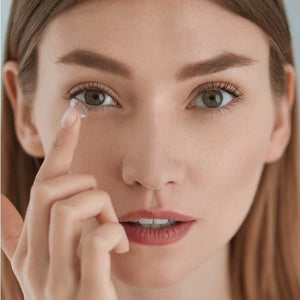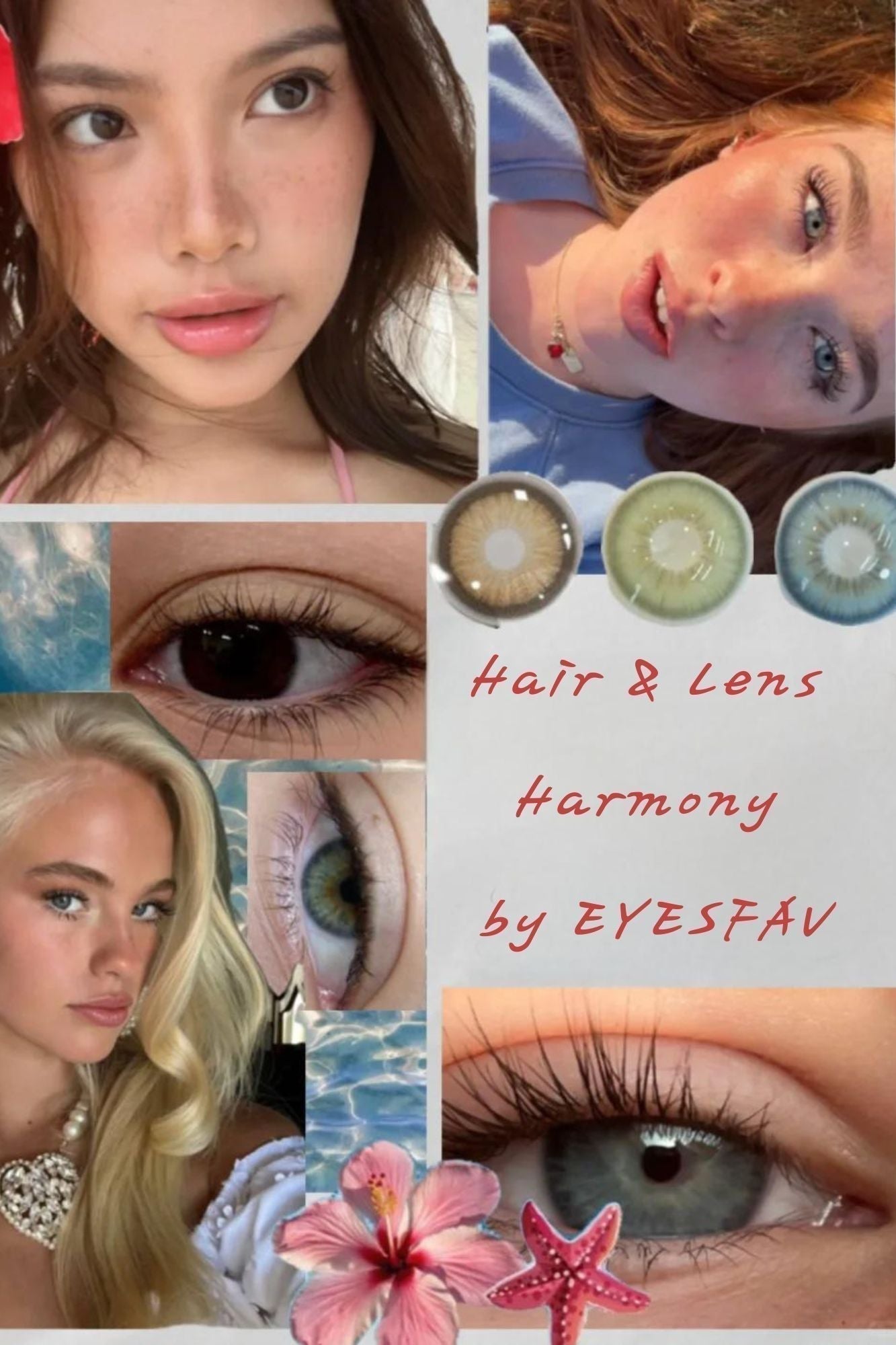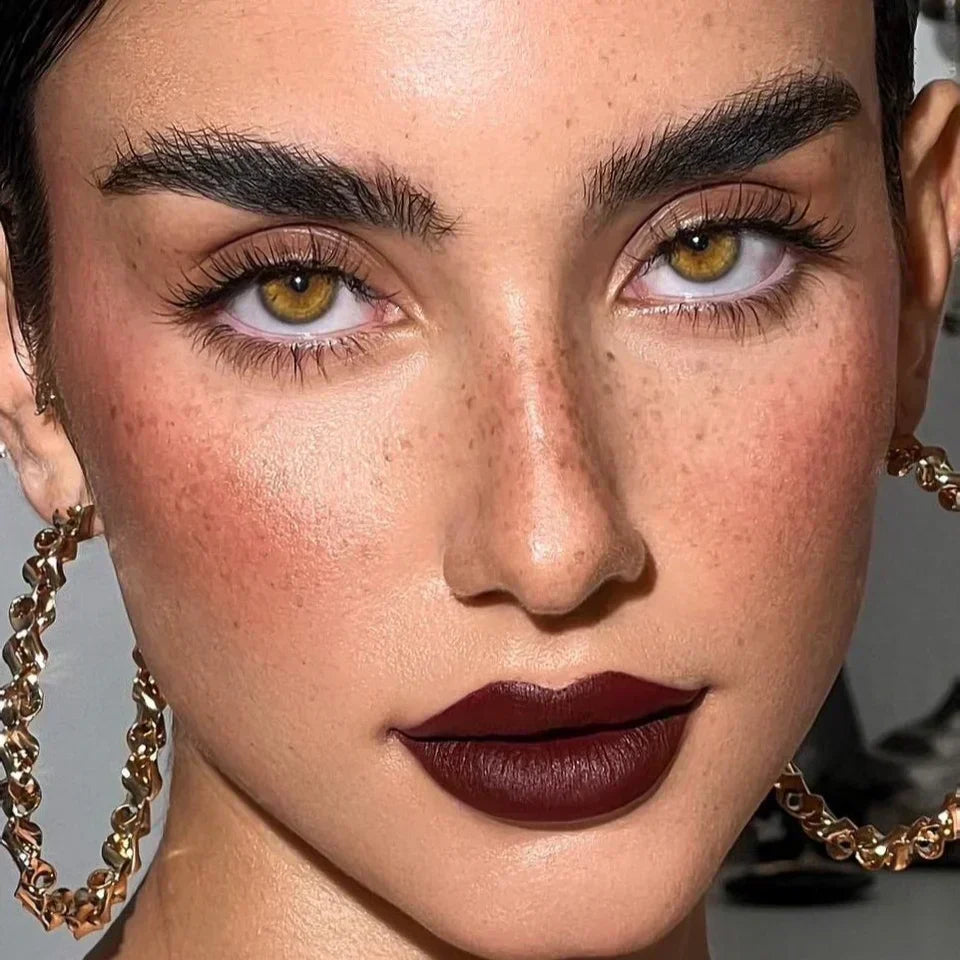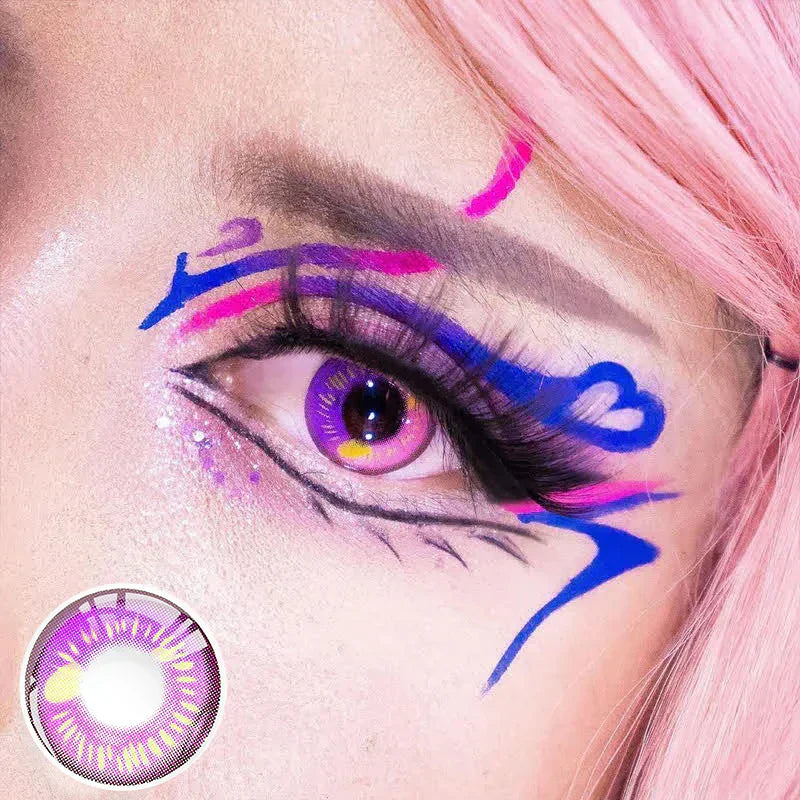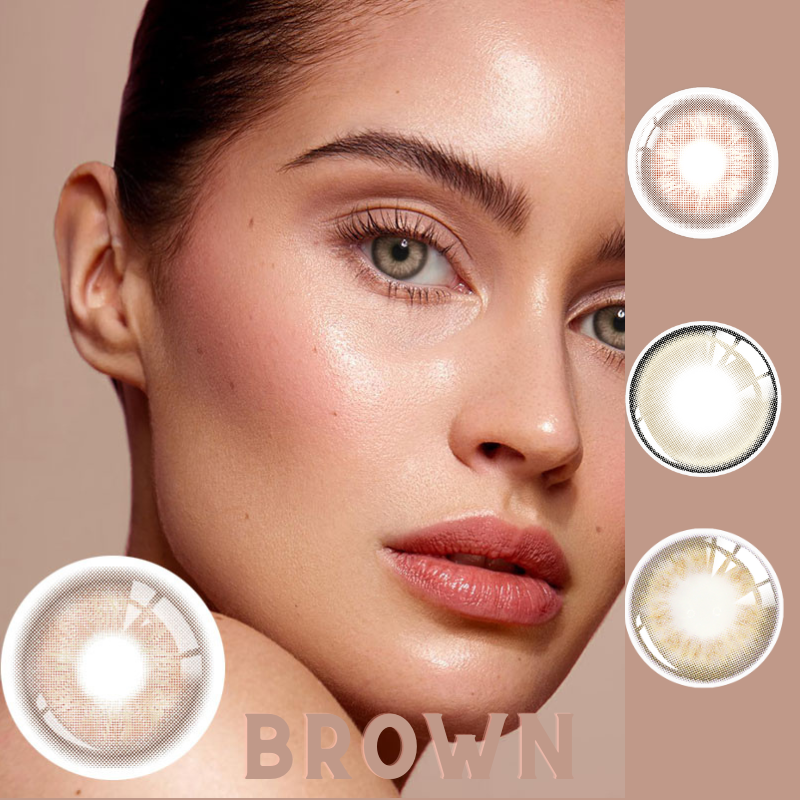جدول المحتويات:
عندما يتعلق الأمر بالنظارات، تتوفر خيارات متعددة، وخاصةً العدسات اللاصقة . من أكثر الأنواع شيوعًا العدسات اللاصقة الملونة والعدسات اللاصقة العادية . ورغم أن كليهما يهدف إلى تحسين الرؤية، إلا أنهما يختلفان اختلافًا واضحًا من حيث المظهر والوظيفة والراحة. سواء كنت تفكر في العدسات اللاصقة الملونة لمظهر جديد أو العدسات اللاصقة العادية لتصحيح الرؤية اليومي، فمن المهم الموازنة بين إيجابيات وسلبيات كل منهما. في هذه المدونة، سنتناول كلا النوعين من العدسات بشكل معمق وممتع وغني بالمعلومات، وسنساعدك في اختيار الأنسب لك!

ما هي العدسات اللاصقة الملونة؟
العدسات اللاصقة الملونة نوع من العدسات التصحيحية أو التجميلية التي تُغيّر لون عينيك الطبيعي. تتوفر بمجموعة واسعة من الألوان، من تحسينات طفيفة إلى تغييرات جذرية.
أنواع العدسات الملونة
عدسات تعزيز اللون: صُممت هذه العدسات لتعزيز لون عينيكِ الطبيعي، خاصةً إذا كانت عيناكِ فاتحتين كالأزرق أو الأخضر. تُضيف هذه العدسات لونًا خفيفًا دون تغيير اللون بشكل كبير.
عدسات ملونة معتمة: تغطي هذه العدسات لون عينيك الطبيعي بالكامل، وتمنحك لونًا جديدًا ثابتًا، مثل الأزرق أو الرمادي أو الأخضر. وهي مثالية لأصحاب العيون الداكنة الذين يرغبون في تغيير ملحوظ.
عدسات تجميلية أو مؤثرات خاصة: صُممت هذه العدسات لإضفاء تحولات جذرية، سواءً كانت إطلالة مرحة أو مخيفة. يمكنها محاكاة أشكال وألوان عيون مختلفة، أو حتى جعل عينيك تبدوان كعيني الزواحف أو مصاصي الدماء.
ما هي العدسات اللاصقة العادية؟
العدسات اللاصقة العادية مصممة لتصحيح مشاكل الرؤية، مثل قصر النظر، وطول النظر، والاستجماتيزم. ورغم أنها لا تُغير لون العين، إلا أنها تُوفر رؤية واضحة، وتتوفر بمواد وتصاميم متنوعة.
أنواع العدسات العادية
العدسات اللاصقة اللينة: تُعد أكثر أنواع العدسات اللاصقة شيوعًا. فهي مريحة وسهلة الارتداء، ومتوفرة بخيارات متعددة، كالارتداء اليومي والأسبوعي والشهري.
العدسات الصلبة النفاذة للغاز (RGP): تتميز هذه العدسات بمتانتها وقدرتها على الرؤية بوضوح أكبر من العدسات اللينة. ورغم أنها أقل مرونة، إلا أنها تُنصح بها عادةً لمن يعانون من بعض مشاكل العين، مثل اللابؤرية.
العدسات التوريكية: تم تصميمها خصيصًا للأشخاص الذين يعانون من الاستجماتيزم، تساعد العدسات التوريكية على تصحيح الرؤية المشوهة من خلال وجود قوى مختلفة في خطوط الطول المختلفة للعدسة.
العدسات متعددة البؤر: تم تصميم هذه العدسات للأشخاص الذين يعانون من طول النظر الشيخوخي، حيث توفر نقاط بؤرية متعددة (مسافات قريبة ومتوسطة وبعيدة) في عدسة واحدة.
إيجابيات العدسات اللاصقة الملونة
تغيير فوري في المظهر: من أبرز مزايا العدسات اللاصقة الملونة قدرتها على تغيير مظهرك فورًا. سواء كنتِ ترغبين في تحسين بسيط أو تغيير كامل في مظهرك، توفر العدسات الملونة طريقة ممتعة لتجربة لون عينيكِ دون الحاجة إلى تغييرات دائمة كالعدسات اللاصقة الملونة أو الجراحة.
التنكر والمؤثرات الخاصة: تُعدّ العدسات اللاصقة الملونة من الإكسسوارات الشائعة في التنكر والعروض المسرحية. فهي تتيح لك اكتساب شخصية جديدة كليًا بتغيير جذري في لون عينيك، أو حتى ابتكار مظهر غريب، مثل عيون القطط أو العدسات البيضاء الغريبة. سواء كنت تحضر حفلة ذات طابع خاص أو تستمتع بوقتك مع أصدقائك، فإن العدسات اللاصقة الملونة تُضفي لمسةً مميزة على إطلالتك.
تعزيز الثقة بالنفس: قد تُعزز العدسات اللاصقة الملونة ثقة بعض الأشخاص بأنفسهم. إذا كنتِ ترغبين دائمًا في لون عيون مختلف، أو ترغبين فقط في تجربة إطلالة جديدة، فهذه العدسات تُمكنكِ من التعبير عن نفسكِ والشعور بمزيد من الثقة. إنها عدسات مؤقتة، ما يُتيح لكِ تغيير إطلالتكِ متى شئتِ!
متوفر بوصفة طبية: أخبار سارة! تتوفر العديد من العدسات اللاصقة الملونة بوصفة طبية. لذا، إذا كنت ترتدي عدسات تصحيحية وترغب بتغيير لون عينيك، يمكنك الاستمتاع بتصحيح النظر ومظهر جديد في آنٍ واحد.
إيجابيات العدسات اللاصقة العادية
تحسين الرؤية: صُممت العدسات اللاصقة العادية، في المقام الأول، لتحسين الرؤية. سواء كنت تعاني من قصر النظر أو طول النظر أو اللابؤرية، فهناك عدسات لاصقة تناسب جميع أنواع عيوب الانكسار تقريبًا. فهي توفر رؤية واضحة وطبيعية دون الحاجة إلى نظارات قد تعيق الرؤية أو تُسبب ضبابية.
الراحة والرفاهية: توفر العدسات اللاصقة العادية، وخاصةً اللينة، راحةً فائقة. فهي لا تنزلق على الأنف، ولا تتكاثف في الطقس البارد، ولا تُعيق مجال الرؤية. يجدها الكثيرون أكثر راحةً من النظارات، خاصةً في الأنشطة الرياضية أو الذهاب إلى النادي الرياضي.
وداعًا لعلامات النظارات: إذا كنتَ قد سئمت من علامات الأنف أو الانزعاج خلف الأذن الذي قد تُسببه النظارات أحيانًا، فإن العدسات اللاصقة العادية هي الحل الأمثل. فهي تُوفر خيارًا مريحًا وغير مزعج يسمح لك بممارسة حياتك اليومية دون القلق بشأن تعديل إطارات نظارتك.
حرية في الأناقة: لأنكِ لا تعتمدين على النظارات، تمنحكِ العدسات اللاصقة العادية حرية تغيير إطلالتكِ بتسريحات شعر متنوعة، أو إكسسوارات، أو حتى مكياج. علاوة على ذلك، مهما كان ما ترتدينه، لا داعي للقلق بشأن ملاءمة نظارتكِ لإطلالتكِ.
سلبيات العدسات اللاصقة الملونة
مشاكل الراحة: على الرغم من أن العدسات اللاصقة الملونة ممتعة ومتعددة الاستخدامات، إلا أنها قد تكون أقل راحة من العدسات العادية. قد تُقلل طبقة اللون أو النمط المضافة أحيانًا من نفاذية العدسة، مما يؤدي إلى جفافها أو تهيجها، خاصةً عند ارتدائها لفترات طويلة.
خيارات محدودة لتصحيح البصر: قد لا تتوفر العدسات اللاصقة الملونة دائمًا في الوصفة الطبية التي تحتاجها، خاصةً إذا كانت لديك احتياجات بصرية أكثر تعقيدًا مثل الاستجماتيزم. حتى مع توفر خيارات الوصفات الطبية، قد لا توفر تصاميم العدسات أقصى دقة رؤية مقارنةً بالعدسات التصحيحية القياسية.
تكلفة أعلى: عادةً ما تكون العدسات اللاصقة الملونة أغلى من العدسات العادية. إذا كنت تستخدمها لأغراض تجميلية ولا تحتاج إلى تصحيح نظر، فقد تتراكم التكاليف بسرعة، خاصةً إذا كنت بحاجة إلى استبدالها بشكل متكرر.
خطر الإصابة بمشاكل صحية في العين: كما هو الحال مع جميع العدسات اللاصقة، قد تزيد العدسات اللاصقة الملونة من خطر الإصابة بمشاكل صحية في العين إذا لم تُستخدم وتُحافظ عليها بشكل صحيح. قد يؤدي سوء النظافة، أو الاستخدام لفترات طويلة، أو استخدام عدسات غير معتمدة من إدارة الغذاء والدواء الأمريكية (FDA) إلى تهيج العين، أو التهابها، أو حتى مضاعفات أكثر خطورة.
سلبيات العدسات اللاصقة العادية
جفاف العين: يجد بعض الأشخاص أن العدسات اللاصقة العادية قد تُسبب جفاف العين، خاصةً بعد ارتدائها لساعات طويلة أو التعرض لبيئات جافة. قد يكون هذا الأمر مزعجًا، وقد يتطلب استخدام قطرات مرطبة للعين للسيطرة عليه.
خطر العدوى: قد يؤدي سوء تنظيف العدسات اللاصقة أو ارتداؤها طوال الليل إلى التهابات خطيرة في العين. من الضروري اتباع تعليمات النظافة والعناية اللازمة لتجنب مضاعفات مثل التهاب الملتحمة أو قرحة القرنية.
الصيانة: تتطلب العدسات اللاصقة العادية صيانة مستمرة. سواءً كان ذلك تنظيفها، أو حفظها في محلول، أو استبدالها في الوقت المناسب، فإن الحفاظ على النظافة السليمة أساسي للحفاظ على صحة عينيك. وهذا أمرٌ آخر يجب مراعاته مقارنةً بسهولة صيانة النظارات.
غير مناسب لجميع حالات العيون: إذا كنت تعاني من بعض حالات العيون، مثل متلازمة جفاف العين أو اضطرابات القرنية، فقد لا تناسبك العدسات اللاصقة العادية. كما يجد بعض الأشخاص أن العدسات اللاصقة لا تتناسب مع نمط حياتهم أو تفضيلاتهم في الراحة.


